Analysis of Discharge Against Medical Advice Rates in ATSI People
VerifiedAdded on 2023/06/11
|7
|1692
|101
Report
AI Summary
This report investigates the elevated rates of Discharge Against Medical Advice (DAMA) within Aboriginal and Torres Strait Islander (ATSI) populations, highlighting disparities in healthcare outcomes compared to non-Indigenous Australians. It attributes these disparities to a combination of social, economic, political, and cultural factors that impact access to and experiences within the healthcare system. Key issues identified include cross-cultural communication barriers, linguistic challenges, social and cultural factors that influence healthcare decisions (particularly for mothers), and negative perceptions of the hospital environment and medical staff attitudes. The report emphasizes the importance of cultural safety in healthcare delivery, suggesting that culturally sensitive practices can improve health outcomes and reduce costs. Ultimately, the report underscores the need for systemic changes to address the factors driving DAMA rates and improve healthcare equity for ATSI communities.
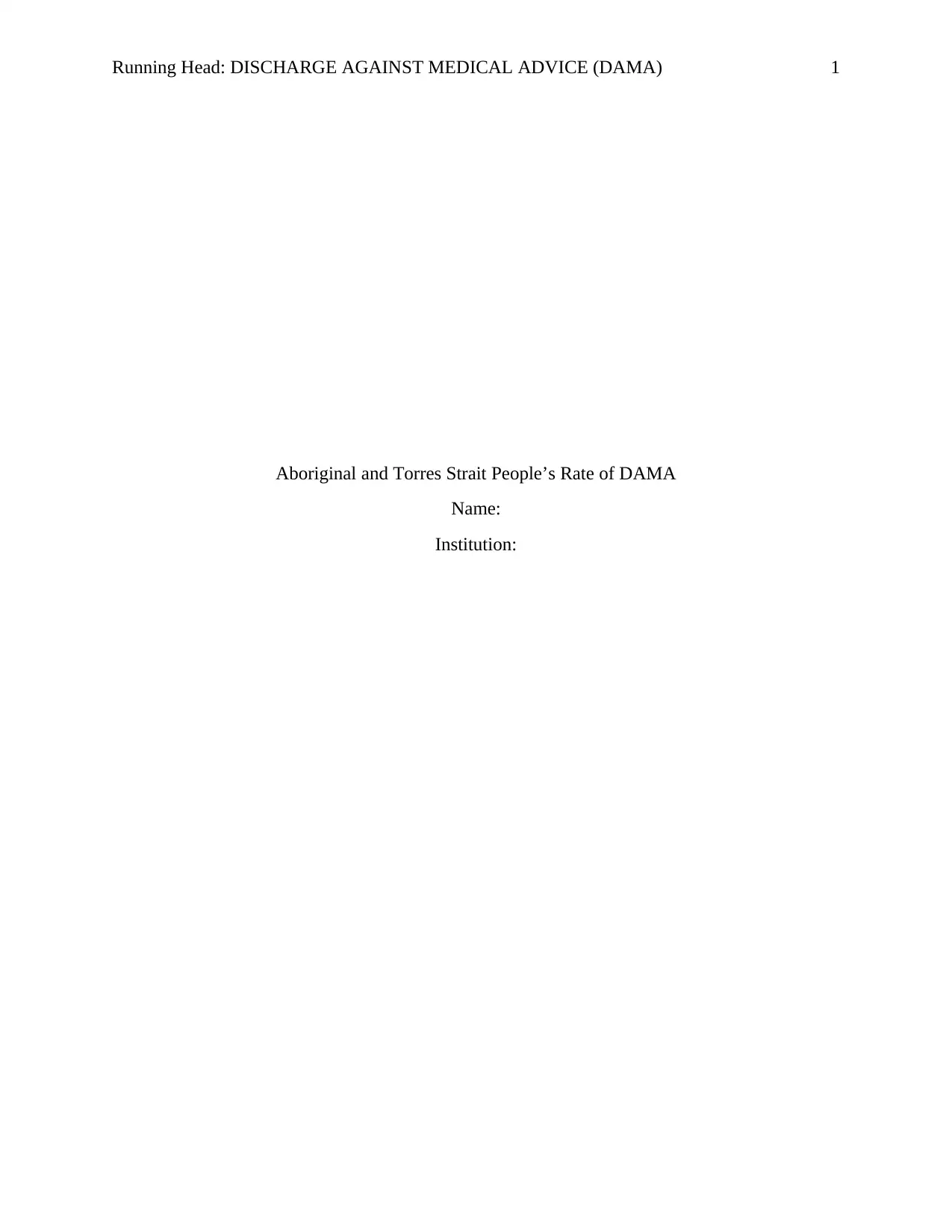
Running Head: DISCHARGE AGAINST MEDICAL ADVICE (DAMA) 1
Aboriginal and Torres Strait People’s Rate of DAMA
Name:
Institution:
Aboriginal and Torres Strait People’s Rate of DAMA
Name:
Institution:
Paraphrase This Document
Need a fresh take? Get an instant paraphrase of this document with our AI Paraphraser
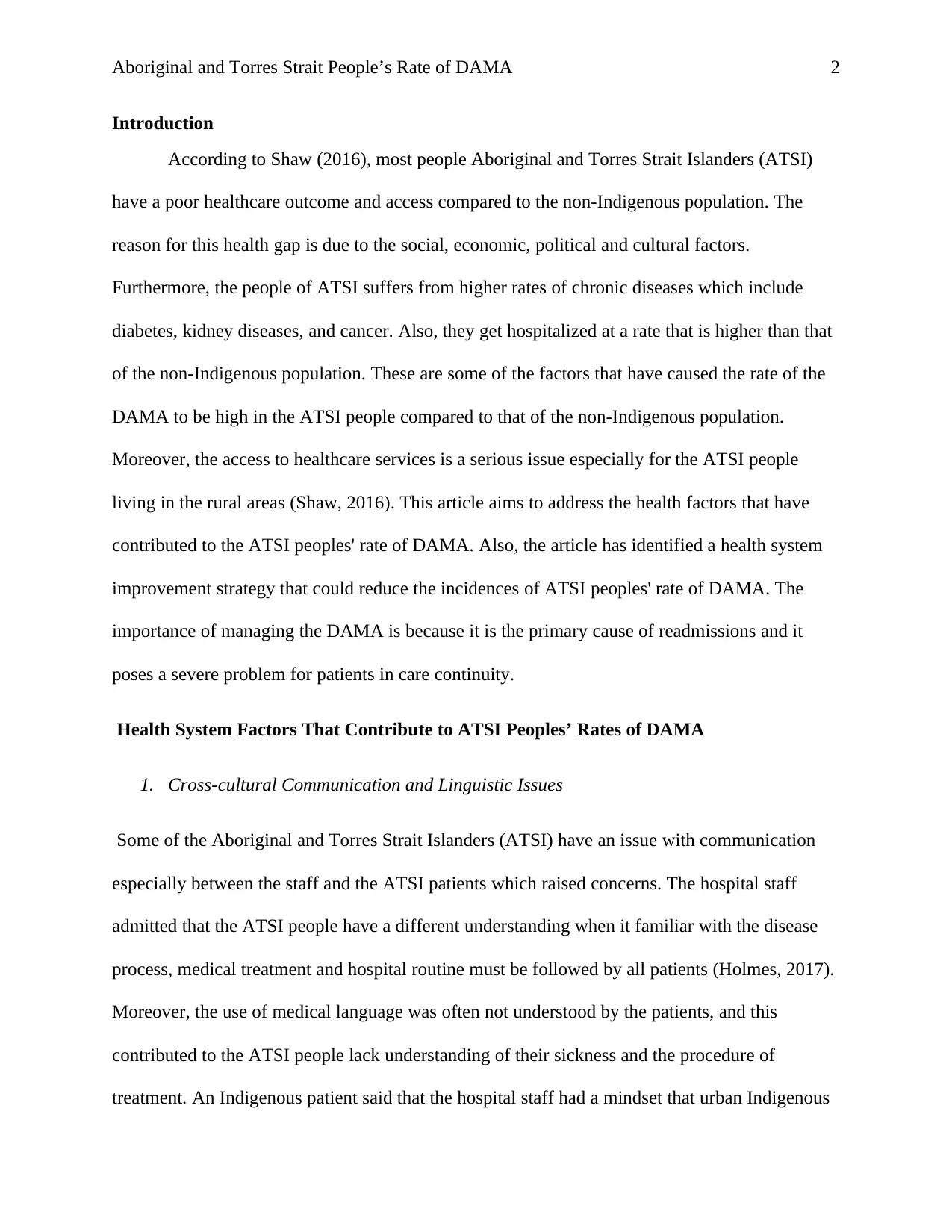
Aboriginal and Torres Strait People’s Rate of DAMA 2
Introduction
According to Shaw (2016), most people Aboriginal and Torres Strait Islanders (ATSI)
have a poor healthcare outcome and access compared to the non-Indigenous population. The
reason for this health gap is due to the social, economic, political and cultural factors.
Furthermore, the people of ATSI suffers from higher rates of chronic diseases which include
diabetes, kidney diseases, and cancer. Also, they get hospitalized at a rate that is higher than that
of the non-Indigenous population. These are some of the factors that have caused the rate of the
DAMA to be high in the ATSI people compared to that of the non-Indigenous population.
Moreover, the access to healthcare services is a serious issue especially for the ATSI people
living in the rural areas (Shaw, 2016). This article aims to address the health factors that have
contributed to the ATSI peoples' rate of DAMA. Also, the article has identified a health system
improvement strategy that could reduce the incidences of ATSI peoples' rate of DAMA. The
importance of managing the DAMA is because it is the primary cause of readmissions and it
poses a severe problem for patients in care continuity.
Health System Factors That Contribute to ATSI Peoples’ Rates of DAMA
1. Cross-cultural Communication and Linguistic Issues
Some of the Aboriginal and Torres Strait Islanders (ATSI) have an issue with communication
especially between the staff and the ATSI patients which raised concerns. The hospital staff
admitted that the ATSI people have a different understanding when it familiar with the disease
process, medical treatment and hospital routine must be followed by all patients (Holmes, 2017).
Moreover, the use of medical language was often not understood by the patients, and this
contributed to the ATSI people lack understanding of their sickness and the procedure of
treatment. An Indigenous patient said that the hospital staff had a mindset that urban Indigenous
Introduction
According to Shaw (2016), most people Aboriginal and Torres Strait Islanders (ATSI)
have a poor healthcare outcome and access compared to the non-Indigenous population. The
reason for this health gap is due to the social, economic, political and cultural factors.
Furthermore, the people of ATSI suffers from higher rates of chronic diseases which include
diabetes, kidney diseases, and cancer. Also, they get hospitalized at a rate that is higher than that
of the non-Indigenous population. These are some of the factors that have caused the rate of the
DAMA to be high in the ATSI people compared to that of the non-Indigenous population.
Moreover, the access to healthcare services is a serious issue especially for the ATSI people
living in the rural areas (Shaw, 2016). This article aims to address the health factors that have
contributed to the ATSI peoples' rate of DAMA. Also, the article has identified a health system
improvement strategy that could reduce the incidences of ATSI peoples' rate of DAMA. The
importance of managing the DAMA is because it is the primary cause of readmissions and it
poses a severe problem for patients in care continuity.
Health System Factors That Contribute to ATSI Peoples’ Rates of DAMA
1. Cross-cultural Communication and Linguistic Issues
Some of the Aboriginal and Torres Strait Islanders (ATSI) have an issue with communication
especially between the staff and the ATSI patients which raised concerns. The hospital staff
admitted that the ATSI people have a different understanding when it familiar with the disease
process, medical treatment and hospital routine must be followed by all patients (Holmes, 2017).
Moreover, the use of medical language was often not understood by the patients, and this
contributed to the ATSI people lack understanding of their sickness and the procedure of
treatment. An Indigenous patient said that the hospital staff had a mindset that urban Indigenous
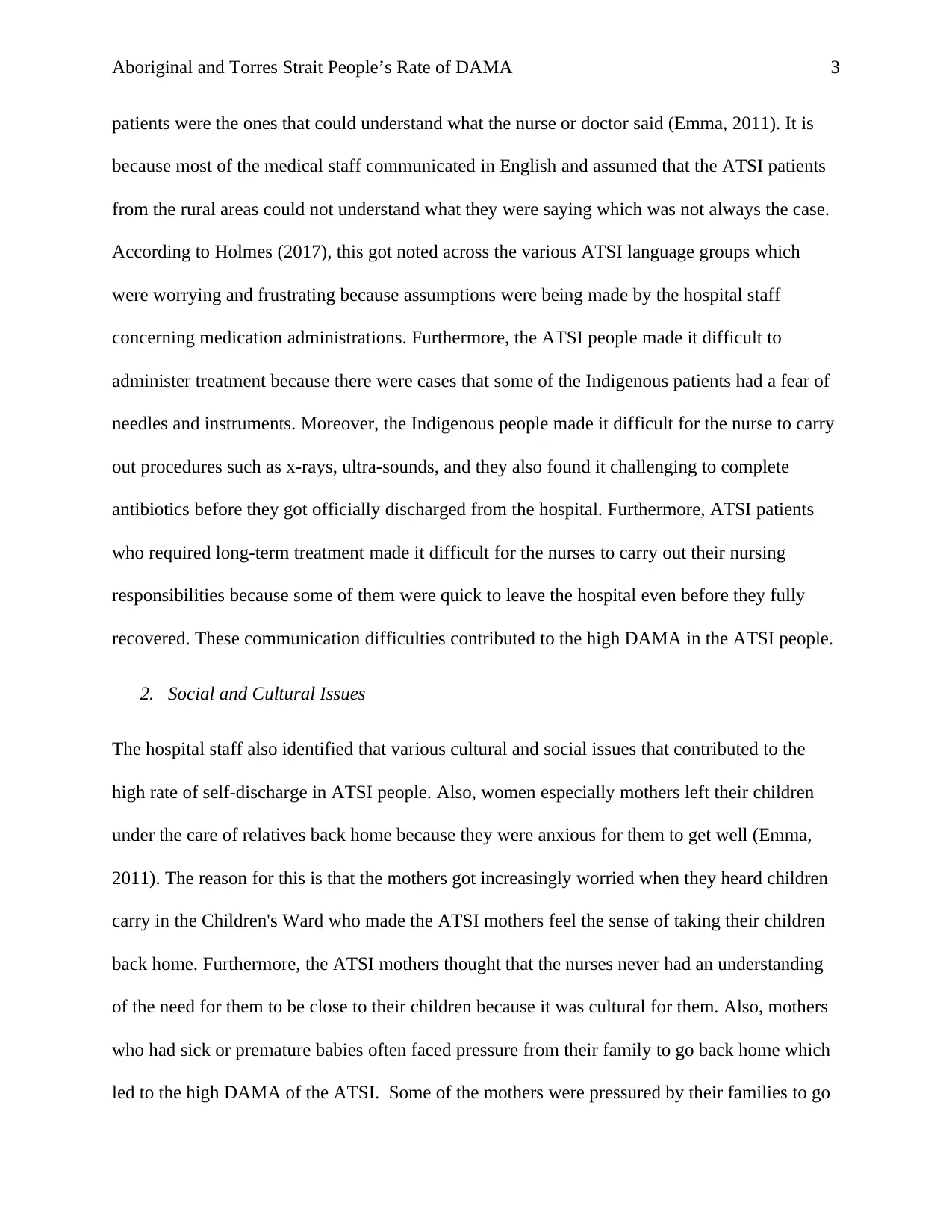
Aboriginal and Torres Strait People’s Rate of DAMA 3
patients were the ones that could understand what the nurse or doctor said (Emma, 2011). It is
because most of the medical staff communicated in English and assumed that the ATSI patients
from the rural areas could not understand what they were saying which was not always the case.
According to Holmes (2017), this got noted across the various ATSI language groups which
were worrying and frustrating because assumptions were being made by the hospital staff
concerning medication administrations. Furthermore, the ATSI people made it difficult to
administer treatment because there were cases that some of the Indigenous patients had a fear of
needles and instruments. Moreover, the Indigenous people made it difficult for the nurse to carry
out procedures such as x-rays, ultra-sounds, and they also found it challenging to complete
antibiotics before they got officially discharged from the hospital. Furthermore, ATSI patients
who required long-term treatment made it difficult for the nurses to carry out their nursing
responsibilities because some of them were quick to leave the hospital even before they fully
recovered. These communication difficulties contributed to the high DAMA in the ATSI people.
2. Social and Cultural Issues
The hospital staff also identified that various cultural and social issues that contributed to the
high rate of self-discharge in ATSI people. Also, women especially mothers left their children
under the care of relatives back home because they were anxious for them to get well (Emma,
2011). The reason for this is that the mothers got increasingly worried when they heard children
carry in the Children's Ward who made the ATSI mothers feel the sense of taking their children
back home. Furthermore, the ATSI mothers thought that the nurses never had an understanding
of the need for them to be close to their children because it was cultural for them. Also, mothers
who had sick or premature babies often faced pressure from their family to go back home which
led to the high DAMA of the ATSI. Some of the mothers were pressured by their families to go
patients were the ones that could understand what the nurse or doctor said (Emma, 2011). It is
because most of the medical staff communicated in English and assumed that the ATSI patients
from the rural areas could not understand what they were saying which was not always the case.
According to Holmes (2017), this got noted across the various ATSI language groups which
were worrying and frustrating because assumptions were being made by the hospital staff
concerning medication administrations. Furthermore, the ATSI people made it difficult to
administer treatment because there were cases that some of the Indigenous patients had a fear of
needles and instruments. Moreover, the Indigenous people made it difficult for the nurse to carry
out procedures such as x-rays, ultra-sounds, and they also found it challenging to complete
antibiotics before they got officially discharged from the hospital. Furthermore, ATSI patients
who required long-term treatment made it difficult for the nurses to carry out their nursing
responsibilities because some of them were quick to leave the hospital even before they fully
recovered. These communication difficulties contributed to the high DAMA in the ATSI people.
2. Social and Cultural Issues
The hospital staff also identified that various cultural and social issues that contributed to the
high rate of self-discharge in ATSI people. Also, women especially mothers left their children
under the care of relatives back home because they were anxious for them to get well (Emma,
2011). The reason for this is that the mothers got increasingly worried when they heard children
carry in the Children's Ward who made the ATSI mothers feel the sense of taking their children
back home. Furthermore, the ATSI mothers thought that the nurses never had an understanding
of the need for them to be close to their children because it was cultural for them. Also, mothers
who had sick or premature babies often faced pressure from their family to go back home which
led to the high DAMA of the ATSI. Some of the mothers were pressured by their families to go
⊘ This is a preview!⊘
Do you want full access?
Subscribe today to unlock all pages.

Trusted by 1+ million students worldwide
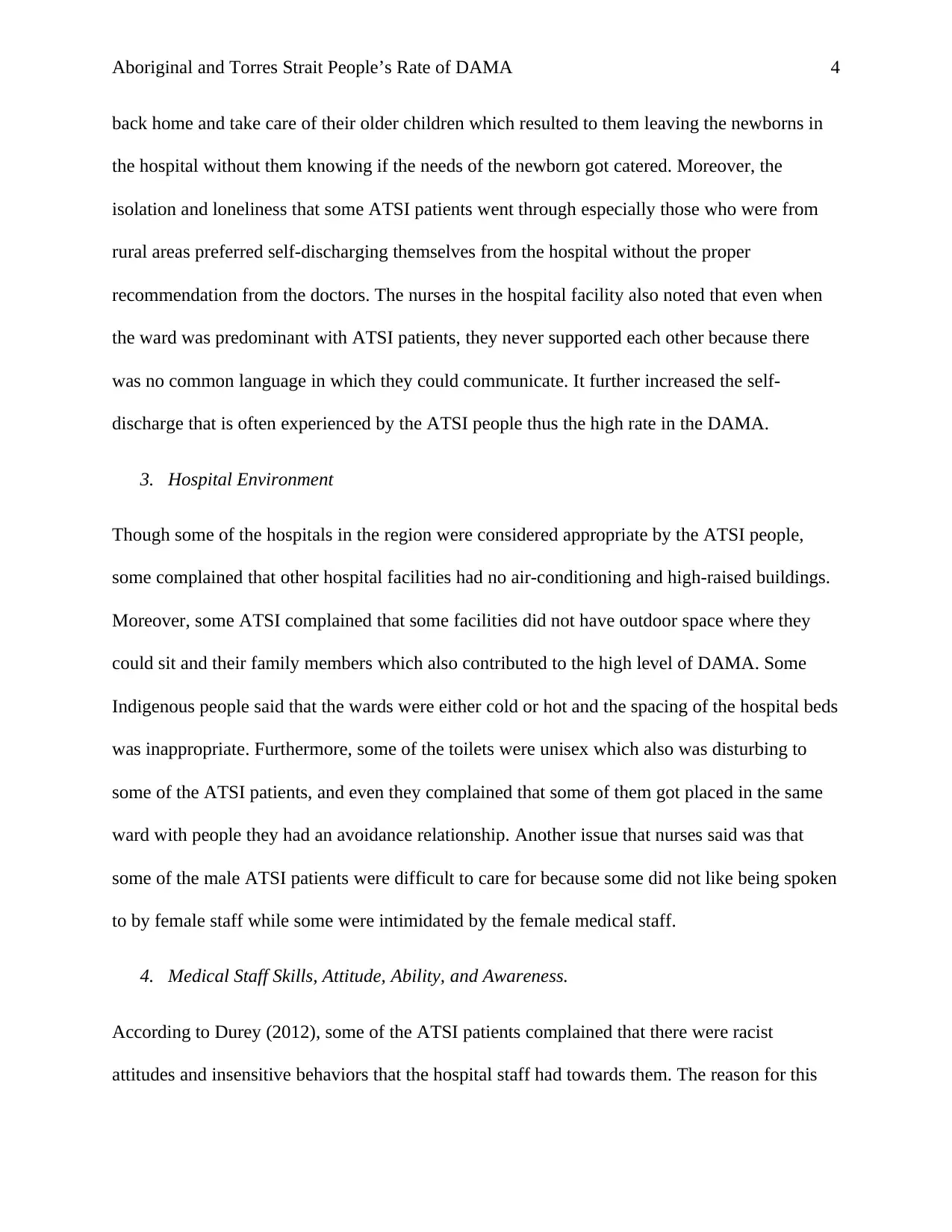
Aboriginal and Torres Strait People’s Rate of DAMA 4
back home and take care of their older children which resulted to them leaving the newborns in
the hospital without them knowing if the needs of the newborn got catered. Moreover, the
isolation and loneliness that some ATSI patients went through especially those who were from
rural areas preferred self-discharging themselves from the hospital without the proper
recommendation from the doctors. The nurses in the hospital facility also noted that even when
the ward was predominant with ATSI patients, they never supported each other because there
was no common language in which they could communicate. It further increased the self-
discharge that is often experienced by the ATSI people thus the high rate in the DAMA.
3. Hospital Environment
Though some of the hospitals in the region were considered appropriate by the ATSI people,
some complained that other hospital facilities had no air-conditioning and high-raised buildings.
Moreover, some ATSI complained that some facilities did not have outdoor space where they
could sit and their family members which also contributed to the high level of DAMA. Some
Indigenous people said that the wards were either cold or hot and the spacing of the hospital beds
was inappropriate. Furthermore, some of the toilets were unisex which also was disturbing to
some of the ATSI patients, and even they complained that some of them got placed in the same
ward with people they had an avoidance relationship. Another issue that nurses said was that
some of the male ATSI patients were difficult to care for because some did not like being spoken
to by female staff while some were intimidated by the female medical staff.
4. Medical Staff Skills, Attitude, Ability, and Awareness.
According to Durey (2012), some of the ATSI patients complained that there were racist
attitudes and insensitive behaviors that the hospital staff had towards them. The reason for this
back home and take care of their older children which resulted to them leaving the newborns in
the hospital without them knowing if the needs of the newborn got catered. Moreover, the
isolation and loneliness that some ATSI patients went through especially those who were from
rural areas preferred self-discharging themselves from the hospital without the proper
recommendation from the doctors. The nurses in the hospital facility also noted that even when
the ward was predominant with ATSI patients, they never supported each other because there
was no common language in which they could communicate. It further increased the self-
discharge that is often experienced by the ATSI people thus the high rate in the DAMA.
3. Hospital Environment
Though some of the hospitals in the region were considered appropriate by the ATSI people,
some complained that other hospital facilities had no air-conditioning and high-raised buildings.
Moreover, some ATSI complained that some facilities did not have outdoor space where they
could sit and their family members which also contributed to the high level of DAMA. Some
Indigenous people said that the wards were either cold or hot and the spacing of the hospital beds
was inappropriate. Furthermore, some of the toilets were unisex which also was disturbing to
some of the ATSI patients, and even they complained that some of them got placed in the same
ward with people they had an avoidance relationship. Another issue that nurses said was that
some of the male ATSI patients were difficult to care for because some did not like being spoken
to by female staff while some were intimidated by the female medical staff.
4. Medical Staff Skills, Attitude, Ability, and Awareness.
According to Durey (2012), some of the ATSI patients complained that there were racist
attitudes and insensitive behaviors that the hospital staff had towards them. The reason for this
Paraphrase This Document
Need a fresh take? Get an instant paraphrase of this document with our AI Paraphraser
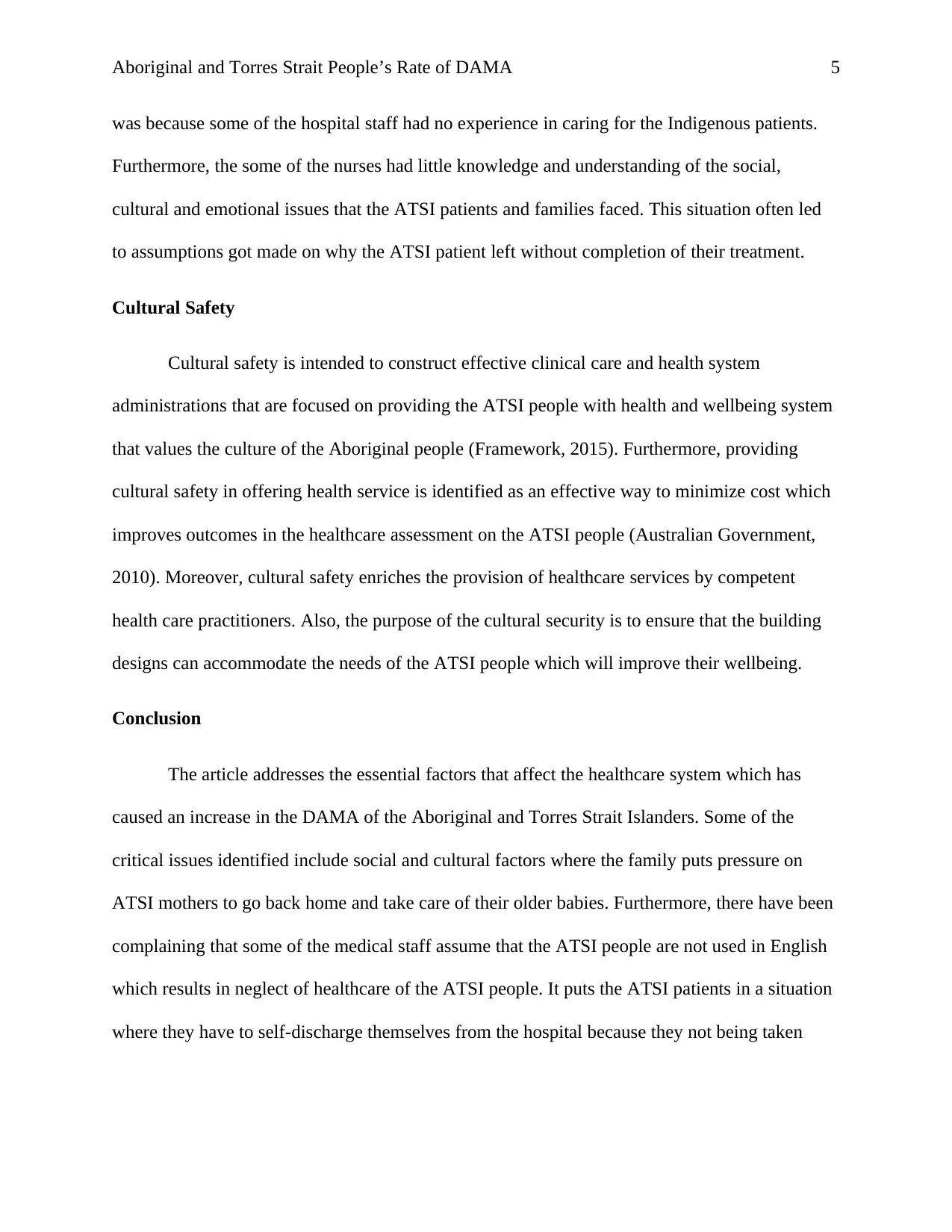
Aboriginal and Torres Strait People’s Rate of DAMA 5
was because some of the hospital staff had no experience in caring for the Indigenous patients.
Furthermore, the some of the nurses had little knowledge and understanding of the social,
cultural and emotional issues that the ATSI patients and families faced. This situation often led
to assumptions got made on why the ATSI patient left without completion of their treatment.
Cultural Safety
Cultural safety is intended to construct effective clinical care and health system
administrations that are focused on providing the ATSI people with health and wellbeing system
that values the culture of the Aboriginal people (Framework, 2015). Furthermore, providing
cultural safety in offering health service is identified as an effective way to minimize cost which
improves outcomes in the healthcare assessment on the ATSI people (Australian Government,
2010). Moreover, cultural safety enriches the provision of healthcare services by competent
health care practitioners. Also, the purpose of the cultural security is to ensure that the building
designs can accommodate the needs of the ATSI people which will improve their wellbeing.
Conclusion
The article addresses the essential factors that affect the healthcare system which has
caused an increase in the DAMA of the Aboriginal and Torres Strait Islanders. Some of the
critical issues identified include social and cultural factors where the family puts pressure on
ATSI mothers to go back home and take care of their older babies. Furthermore, there have been
complaining that some of the medical staff assume that the ATSI people are not used in English
which results in neglect of healthcare of the ATSI people. It puts the ATSI patients in a situation
where they have to self-discharge themselves from the hospital because they not being taken
was because some of the hospital staff had no experience in caring for the Indigenous patients.
Furthermore, the some of the nurses had little knowledge and understanding of the social,
cultural and emotional issues that the ATSI patients and families faced. This situation often led
to assumptions got made on why the ATSI patient left without completion of their treatment.
Cultural Safety
Cultural safety is intended to construct effective clinical care and health system
administrations that are focused on providing the ATSI people with health and wellbeing system
that values the culture of the Aboriginal people (Framework, 2015). Furthermore, providing
cultural safety in offering health service is identified as an effective way to minimize cost which
improves outcomes in the healthcare assessment on the ATSI people (Australian Government,
2010). Moreover, cultural safety enriches the provision of healthcare services by competent
health care practitioners. Also, the purpose of the cultural security is to ensure that the building
designs can accommodate the needs of the ATSI people which will improve their wellbeing.
Conclusion
The article addresses the essential factors that affect the healthcare system which has
caused an increase in the DAMA of the Aboriginal and Torres Strait Islanders. Some of the
critical issues identified include social and cultural factors where the family puts pressure on
ATSI mothers to go back home and take care of their older babies. Furthermore, there have been
complaining that some of the medical staff assume that the ATSI people are not used in English
which results in neglect of healthcare of the ATSI people. It puts the ATSI patients in a situation
where they have to self-discharge themselves from the hospital because they not being taken
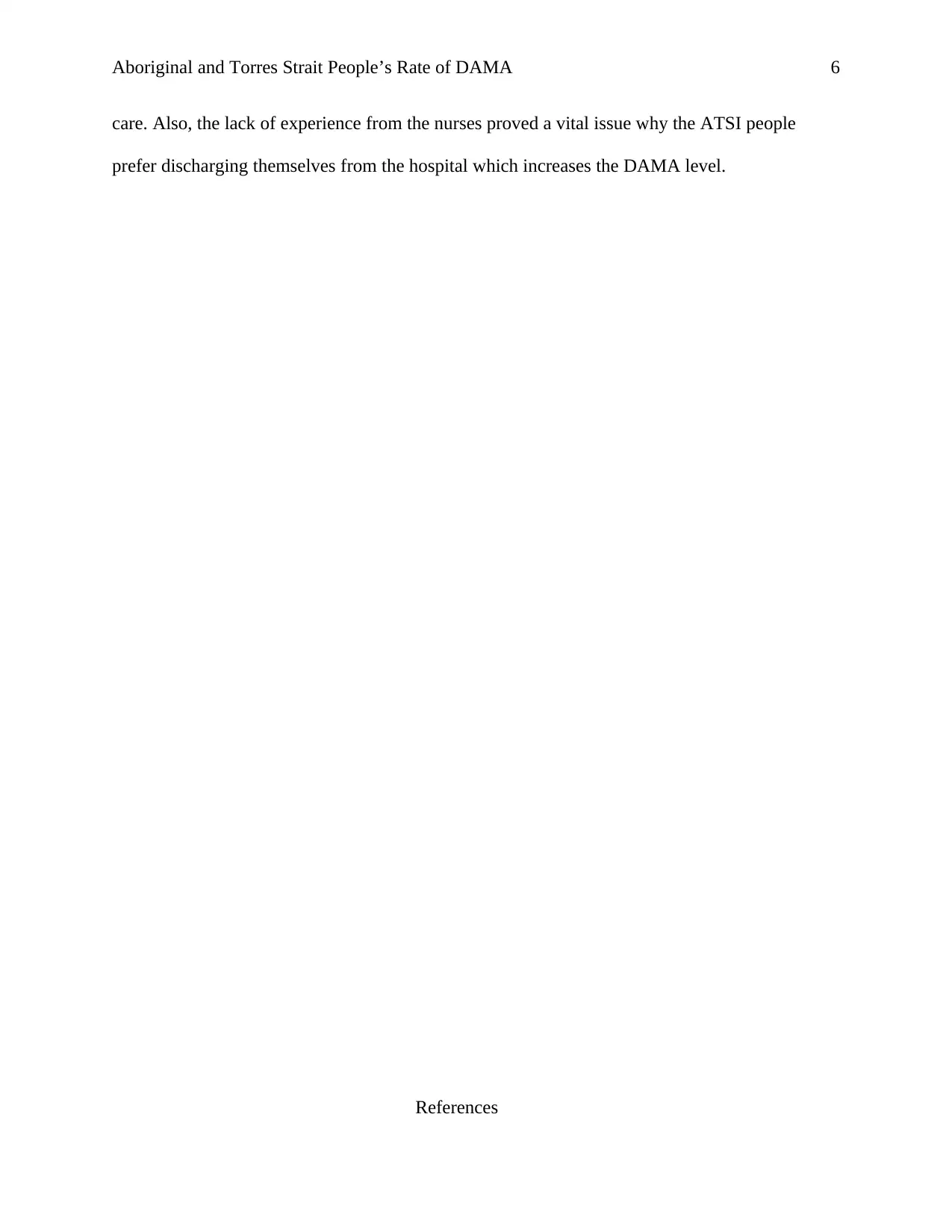
Aboriginal and Torres Strait People’s Rate of DAMA 6
care. Also, the lack of experience from the nurses proved a vital issue why the ATSI people
prefer discharging themselves from the hospital which increases the DAMA level.
References
care. Also, the lack of experience from the nurses proved a vital issue why the ATSI people
prefer discharging themselves from the hospital which increases the DAMA level.
References
⊘ This is a preview!⊘
Do you want full access?
Subscribe today to unlock all pages.

Trusted by 1+ million students worldwide
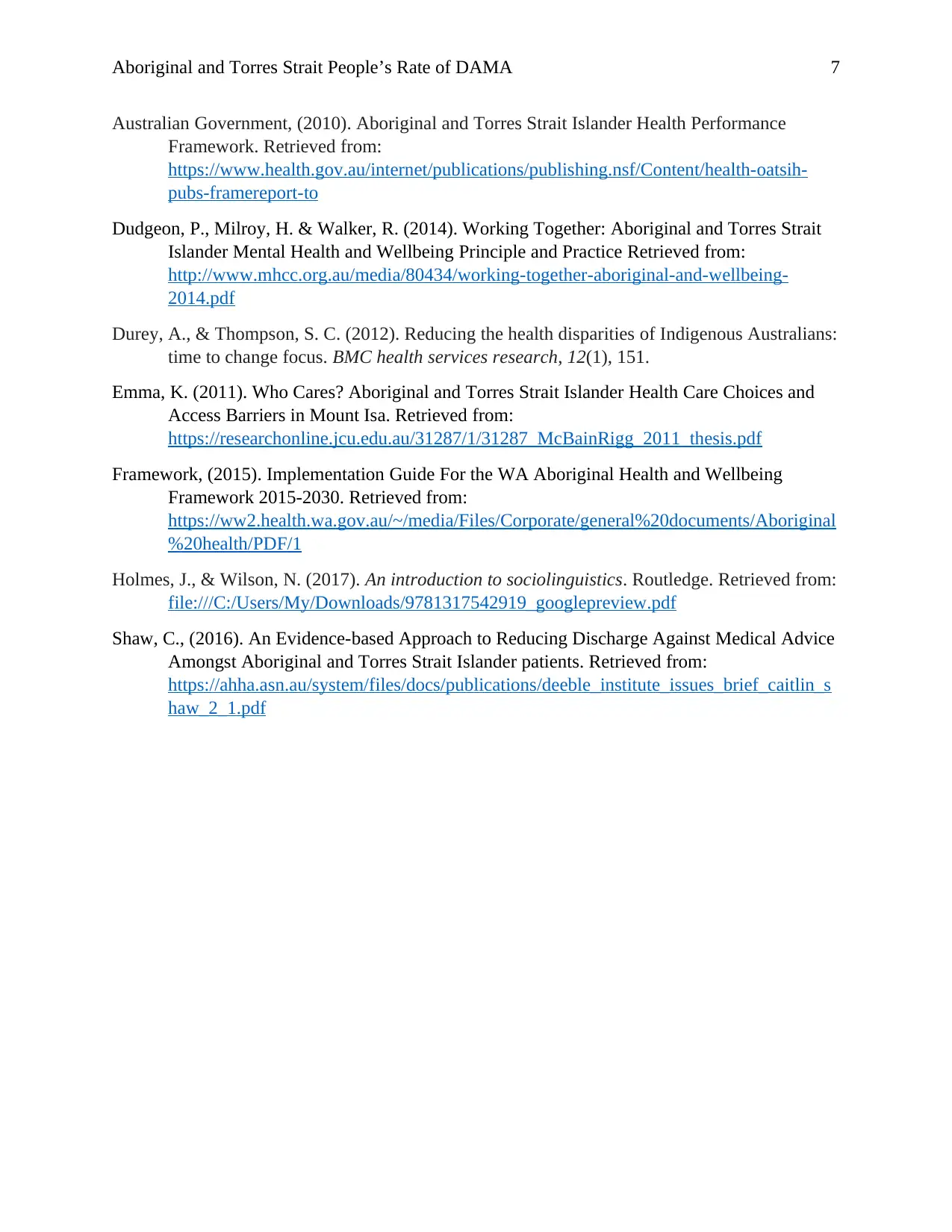
Aboriginal and Torres Strait People’s Rate of DAMA 7
Australian Government, (2010). Aboriginal and Torres Strait Islander Health Performance
Framework. Retrieved from:
https://www.health.gov.au/internet/publications/publishing.nsf/Content/health-oatsih-
pubs-framereport-to
Dudgeon, P., Milroy, H. & Walker, R. (2014). Working Together: Aboriginal and Torres Strait
Islander Mental Health and Wellbeing Principle and Practice Retrieved from:
http://www.mhcc.org.au/media/80434/working-together-aboriginal-and-wellbeing-
2014.pdf
Durey, A., & Thompson, S. C. (2012). Reducing the health disparities of Indigenous Australians:
time to change focus. BMC health services research, 12(1), 151.
Emma, K. (2011). Who Cares? Aboriginal and Torres Strait Islander Health Care Choices and
Access Barriers in Mount Isa. Retrieved from:
https://researchonline.jcu.edu.au/31287/1/31287_McBainRigg_2011_thesis.pdf
Framework, (2015). Implementation Guide For the WA Aboriginal Health and Wellbeing
Framework 2015-2030. Retrieved from:
https://ww2.health.wa.gov.au/~/media/Files/Corporate/general%20documents/Aboriginal
%20health/PDF/1
Holmes, J., & Wilson, N. (2017). An introduction to sociolinguistics. Routledge. Retrieved from:
file:///C:/Users/My/Downloads/9781317542919_googlepreview.pdf
Shaw, C., (2016). An Evidence-based Approach to Reducing Discharge Against Medical Advice
Amongst Aboriginal and Torres Strait Islander patients. Retrieved from:
https://ahha.asn.au/system/files/docs/publications/deeble_institute_issues_brief_caitlin_s
haw_2_1.pdf
Australian Government, (2010). Aboriginal and Torres Strait Islander Health Performance
Framework. Retrieved from:
https://www.health.gov.au/internet/publications/publishing.nsf/Content/health-oatsih-
pubs-framereport-to
Dudgeon, P., Milroy, H. & Walker, R. (2014). Working Together: Aboriginal and Torres Strait
Islander Mental Health and Wellbeing Principle and Practice Retrieved from:
http://www.mhcc.org.au/media/80434/working-together-aboriginal-and-wellbeing-
2014.pdf
Durey, A., & Thompson, S. C. (2012). Reducing the health disparities of Indigenous Australians:
time to change focus. BMC health services research, 12(1), 151.
Emma, K. (2011). Who Cares? Aboriginal and Torres Strait Islander Health Care Choices and
Access Barriers in Mount Isa. Retrieved from:
https://researchonline.jcu.edu.au/31287/1/31287_McBainRigg_2011_thesis.pdf
Framework, (2015). Implementation Guide For the WA Aboriginal Health and Wellbeing
Framework 2015-2030. Retrieved from:
https://ww2.health.wa.gov.au/~/media/Files/Corporate/general%20documents/Aboriginal
%20health/PDF/1
Holmes, J., & Wilson, N. (2017). An introduction to sociolinguistics. Routledge. Retrieved from:
file:///C:/Users/My/Downloads/9781317542919_googlepreview.pdf
Shaw, C., (2016). An Evidence-based Approach to Reducing Discharge Against Medical Advice
Amongst Aboriginal and Torres Strait Islander patients. Retrieved from:
https://ahha.asn.au/system/files/docs/publications/deeble_institute_issues_brief_caitlin_s
haw_2_1.pdf
1 out of 7
Related Documents
Your All-in-One AI-Powered Toolkit for Academic Success.
+13062052269
info@desklib.com
Available 24*7 on WhatsApp / Email
![[object Object]](/_next/static/media/star-bottom.7253800d.svg)
Unlock your academic potential
Copyright © 2020–2025 A2Z Services. All Rights Reserved. Developed and managed by ZUCOL.





